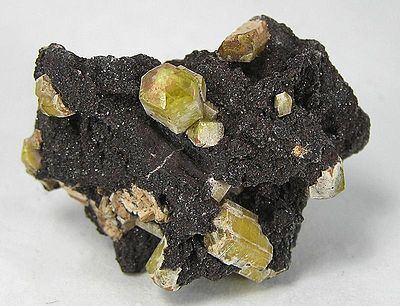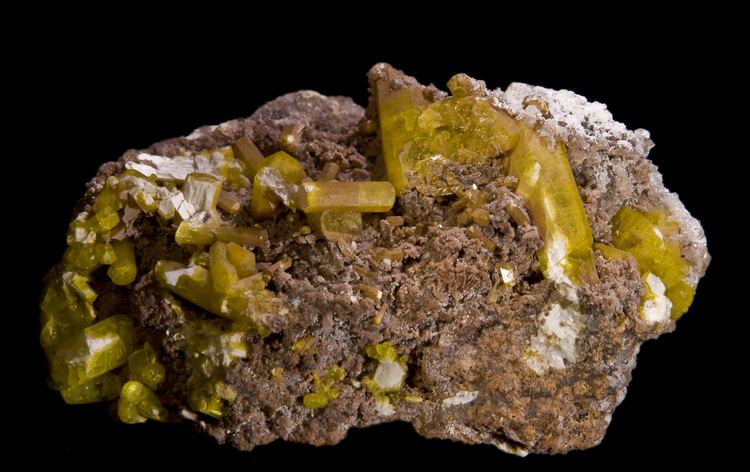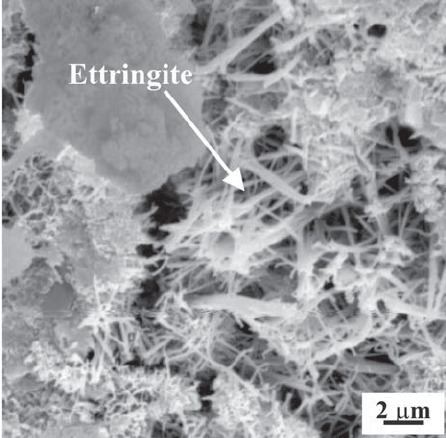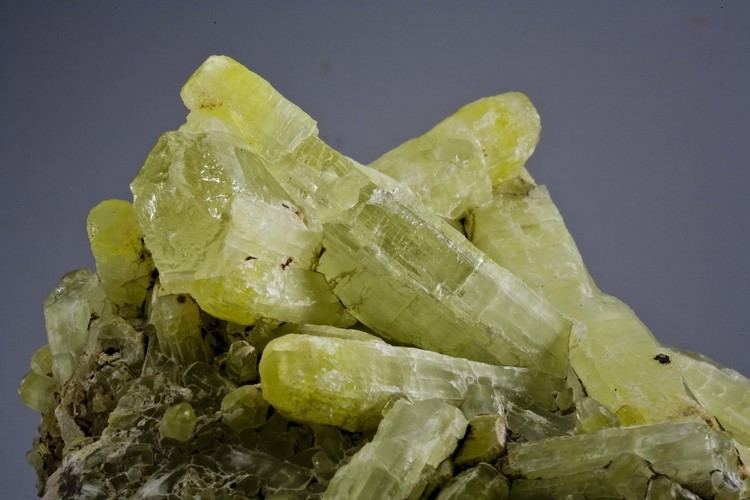Category Sulfate minerals Crystal system Trigonal | Strunz classification 7.DG.15 Space group P31c | |
Formula(repeating unit) Ca6Al2(SO4)3(OH)12·26H2O Crystal class Ditrigonal pyramidal (3m)H-M symbol: (3m) | ||
Alex schauss ettringite
Ettringite is a hydrous calcium aluminium sulfate mineral with formula: Ca6Al2(SO4)3(OH)12·26H2O. It is a colorless to yellow mineral crystallizing in the trigonal system. The prismatic crystals are typically colorless, turning white on partial dehydration. It is part of the ettringite-group which includes other sulfates such as thaumasite and bentorite.
Contents
- Alex schauss ettringite
- What does ettringite mean
- Discovery and occurrence
- Occurrence in cement
- AFt and AFm phases
- Structure
- Further research
- References

What does ettringite mean
Discovery and occurrence

Ettringite was first described in 1874 by J.Lehmann, for an occurrence near the Ettringer Bellerberg volcano, Ettringen, Rheinland-Pfalz, Germany. It occurs within metamorphically altered limestone adjacent to igneous intrusive rocks or within xenoliths. It also occurs as weathering crusts on larnite in the Hatrurim Formation of Israel. It occurs associated with portlandite, afwillite and hydrocalumite at Scawt Hill, Ireland and with afwillite, hydrocalumite, mayenite and gypsum in the Hatrurim Formation. It has also been reported from the Zeilberg quarry, Maroldsweisach, Bavaria; at Boisséjour, near Clermont-Ferrand, Puy-de-Dôme, Auvergne, France; the N’Chwaning mine, Kuruman district, Cape Province, South Africa; in the US, occurrences were found in spurrite-merwinite-gehlenite skarn at the 910 level of the Commercial quarry, Crestmore, Riverside County, California and in the Lucky Cuss mine, Tombstone, Cochise County, Arizona.
Occurrence in cement
In concrete chemistry ettringite is a hexacalcium aluminate trisulfate hydrate, of general formula:
(CaO)6(Al2O3)(SO3)3·32H2Oor
(CaO)3(Al2O3)(CaSO4)3·32H2O.
Ettringite is formed in hydrated Portland cement system as a result of the reaction of calcium aluminate with calcium sulfate, both present in Portland cement. Ettringite, the more prominent representative of AFt phases or (Al2O3-Fe2O3-tri), can also be synthesized in the laboratory by reacting stoichiometric amounts of calcium, aluminium and sulfate in water.
C3A + 3 CaSO4 → ettringite
In the cement system, the presence of ettringite depends on the ratio of calcium sulfate to tri-calcium aluminate (C3A); when this ratio is low, ettringite forms during early hydration and then converts to the calcium aluminate monosulfate (AFm phase or (Al2O3-Fe2O3-mono)). When the ratio is intermediate, only a portion of the ettringite converts to AFm and both can coexist, while ettringite is unlikely to convert to AFm at high ratios.
The following characters designate standard notations:
AFt and AFm phases
Structure
The mineral ettringite has a structure that runs parallel to the c axis -the needle axis-; in the middle of these two lie the sulfate ions and H2O molecules, the space group is P31c. Ettringite crystal system is trigonal, crystals are elongated and in a needle like shape, occurrence of disorder or twining is common, which affects the intercolumn material. The first X-ray study was done by Bannister, Hey & Bernal (1936), which found that the crystal unit cell is of a hexagonal form with a=11.26 and c=21.48 with space group P63/mmcand Z=2. From observations on dehydration and chemical formulas there were suggestions of the structure being composed of Ca2+ and Al(OH)63−, were between them lie SO42− ions and H2O molecules. Further X-ray studies ensued; namely Wellin (1956) which determined the crystal structure of thaumasite, and Besjak & Jelenic (1966) which gave affirmation of the structure nature of ettringite.
An ettringite sample extracted from Scawt Hill was analysed by C. E. Tilley, the crystal was 1.1 x 0.8 0.5 mm, with specific gravity of 1.772±0.002, the density was determined by immersing the sample in a solution of carbon tetrachloride mixed with bromoform. The crystal showed five prism faces of the form m {1010} and a small face a{1120}, with no pyramidal or basal faces, upon x-ray diffraction a Lauer gram along the c-axis revealed a hexagonal axis with vertical planes of symmetry, this study showed that the structure has a hexagonal and not a rhombohedral lattice. further studies conducted on synthetic ettringite by use of x-ray and powder diffraction confirmed earlier assumptions and analyses.
Upon analyzing the structure of both ettringite and thaumasite, it was deduced that both minerals have hexagonal structures, but different space groups. Ettringite crystals have a P31c with a=11.224 Å, c= 21,108 Å, while thaumasite crystals fall into space group P63 with a= 11.04 Å, c= 10.39 Å. While these two minerals form a solid solution, the difference in space groups lead to discontinuities in unit cell parameters. Differences between structures of ettringite and thaumasite arise from the columns of cations and anions: Ettringite cation columns are composed of Ca3[Al(OH)6·12H2O]3+, which run parallel to the c axis, and the other columns of sulfate anions and water molecules in channels parallel to these columns. In contrast, thaumasite consists of a cylindrical column of Ca3[Si(OH)6·12H2O]3+ in the c axis, with sulfate and carbonate anions in channels between these columns which contain water molecules as well.
Further research
Ongoing research on ettringite and cement phase minerals is in general to find ways to immobilize wastes and heavy metals from soils and the environment; this can be done by use of the proper cement phase forming mineral by use of lattice to extract according elements. For example, it is reported that copper immobilization at high pH can be achieved through formation of CSH/CAH and ettringite. It is suggested that the crystal morphology of ettringite Ca6Al2(SO4)3(OH)12·26H2O can incorporate a variety of divalent ions: Cu2+, Pb2+, Cd2+ and Zn2+, which can substitute for the Ca2+ by incorporating these ions into the lattice.
